-

新人教版高中英语选修2Unit 3 Using langauge-Listening教学设计
1. How is Hunan cuisine somewhat different from Sichuan cuisine?The heat in Sichuan cuisine comes from chilies and Sichuan peppercorns. Human cuisine is often hotter and the heat comes from just chilies.2.What are the reasons why Hunan people like spicy food?Because they are a bold people. But many Chinese people think that hot food helps them overcome the effects of rainy or wet weather.3.Why do so many people love steamed fish head covered with chilies?People love it because the meat is quite tender and there are very few small bones.4.Why does Tingting recommend bridge tofu instead of dry pot duck with golden buns?Because bridge tofu has a lighter taste.5 .Why is red braised pork the most famous dish?Because Chairman Mao was from Hunan, and this was his favorite food.Step 5: Instruct students to make a short presentation to the class about your choice. Use the example and useful phrases below to help them.? In groups of three, discuss what types of restaurant you would like to take a foreign visitor to, and why. Then take turns role-playing taking your foreign guest to the restaurant you have chosen. One of you should act as the foreign guest, one as the Chinese host, and one as the waiter or waitress. You may start like this:? EXAMPLE? A: I really love spicy food, so what dish would you recommend?? B: I suggest Mapo tofu.? A: Really ? what's that?

新人教版高中英语选修2Unit 4 Learning about Language教学设计
This section guides students to pay attention to the typical context of vocabulary use, helps students accumulate vocabulary around the key vocabulary of this unit, and uses the learned words and word chunks in different contexts to deeply understand their meaning and usage, so as to achieve the purpose of review and consolidation.The teaching design activities aim to guide students to pay attention to the typical context in which the target vocabulary is used, as well as the common vocabulary used in collocation, so that students can complete the sentence with correct words. In terms of vocabulary learning strategies, this unit focuses on cultivating students' ability to pay attention to collocation of words and to use word blocks to express meaning.For vocabulary learning, it is not enough just to know the meaning of a single word, but the most important thing is to master the common collocations of words, namely word blocks.Teachers should timely guide students to summarize common vocabulary collocation, such as verb and noun collocation, verb and preposition collocation, preposition and noun collocation, and so on.1. Guide students to understand and consolidate the meaning and usage of the vocabulary in the context, 2. Guide the students to use the unit topic vocabulary in a richer context3. Let the students sort out and accumulate the accumulated vocabulary, establishes the semantic connection between the vocabulary,4. Enable students to understand and master the vocabulary more effectivelyGuiding the Ss to use unit topic words and the sentence patterns in a richer context.

新人教版高中英语选修2Unit 4 Reading for writing教学设计
假定你是英国的Jack,打算来中国旅行,请你给你的中国笔友李华写一封信,要点如下:1.你的旅行计划:北京→泰山→杭州;2.征求建议并询问他是否愿意充当你的导游。注意:1.词数80左右(开头和结尾已给出,不计入总词数);2.可以适当增加细节,以使行文连贯。参考词汇:故宫 the Forbidden City;泰山 Mount TaiDear Li Hua,I'm glad to tell you that 'm going to visit China.First,I am planning to visit Beijing,the capitalof China,where I am looking forward to enjoying the Great Wall,the Forbidden City and somebeautiful parks.Then I intend to go to visit Mount Tai in Shandong Province.I've heard that it is one ofthe most famous mountains in China and I can't wait to enjoy the amazing sunrise there.After that,I amalso going to Hangzhou.It is said that it is a beautiful modern city with breathtaking natural sights,among which the West Lake is a well- known tourist attraction.What do you think of my travel plan? Will you act as my guide? Hope to hear from you soon.

新人教版高中英语选修2Unit 4 Using langauge-Listening教学设计
The theme of the listening section is " talking about scenery and culture along a journey."The part is designed to further lead the students to understand Canadian natural geography and social environment, and integrated into the cultural contrast by mentioning the long train journey from Beijing to Moscow routes. On this basis, the part activates students related travel experience, lets the student serial dialogue, guides the student to explore further the pleasure and meaning of the long journey, and Chinese and foreign cultural comparison.The part also provides a framework for the continuation of the dialogue, which is designed to provide a framework for students to successfully complete their oral expressions, and to incorporate an important trading strategy to end the dialogue naturally.1. Help students to understand and master some common English idioms in the context, and experience the expression effect of English idioms.2. Guide the students to understand the identity of different people in the listening context, and finish the dialogue according to their own experience.3. Instruct the students to use appropriate language to express surprise and curiosity about space and place in the dialogue, and master the oral strategy of ending the dialogue naturally.1. Instruct students to grasp the key information and important details of the dialogue.2. Instruct students to conduct a similar talk on the relevant topic.

新人教版高中英语选修2Unit 5 Learning about Language教学设计
The purpose of this section of vocabulary exercises is to consolidate the key words in the first part of the reading text, let the students write the words according to the English definition, and focus on the detection of the meaning and spelling of the new words. The teaching design includes use English definition to explain words, which is conducive to improving students' interest in vocabulary learning, cultivating their sense of English language and thinking in English, and making students willing to use this method to better grasp the meaning of words, expand their vocabulary, and improve their ability of vocabulary application. Besides, the design offers more context including sentences and short passage for students to practice words flexibly.1. Guide students to understand and consolidate the meaning and usage of the vocabulary in the context, 2. Guide the students to use the unit topic vocabulary in a richer context3. Let the students sort out and accumulate the accumulated vocabulary, establishes the semantic connection between the vocabulary,4. Enable students to understand and master the vocabulary more effectivelyGuiding the Ss to use unit topic words and the sentence patterns in a richer context.Step1: Read the passage about chemical burns and fill in the blanks with the correct forms of the words in the box.

新人教版高中英语选修2Unit 5 Reading and thinking教学设计
The theme of this activity is to learn the first aid knowledge of burns. Burns is common in life, but there are some misunderstandings in manual treatment. This activity provides students with correct first aid methods, so as not to take them for granted in an emergency. This section guides students to analyze the causes of scald and help students avoid such things. From the perspective of text structure and collaborative features, the text is expository. Expository, with explanation as the main way of expression, transmits knowledge and information to readers by analyzing concepts and elaborating examples. This text arranges the information in logical order, clearly presents three parts of the content through the subtitle, accurately describes the causes, types, characteristics and first aid measures of burns, and some paragraphs use topic sentences to summarize the main idea, and the level is very clear.1. Guide students to understand the causes, types, characteristics and first aid methods of burns, through reading2. Enhance students’ ability to deal withburnss and their awareness of burns prevention3. Enable students to improve the ability to judge the types of texts accurately and to master the characteristics and writing techniques of expository texts.Guide students to understand the causes, types, characteristics and first aid methods of burns, through readingStep1: Lead in by discussing the related topic:1. What first-aid techniques do you know of ?CPR; mouth to mouth artificial respiration; the Heimlich Manoeuvre

新人教版高中英语选修2Unit 5 Using langauge-Listening教学设计
The theme of this section is to learn how to make emergency calls. Students should learn how to make emergency calls not only in China, but also in foreign countries in English, so that they can be prepared for future situations outside the home.The emergency telephone number is a vital hotline, which should be the most clear, rapid and effective communication with the acute operator.This section helps students to understand the emergency calls in some countries and the precautions for making emergency calls. Through the study of this section, students can accumulate common expressions and sentence patterns in this context. 1.Help students accumulate emergency telephone numbers in different countries and learn more about first aid2.Guide the students to understand the contents and instructions of the telephone, grasp the characteristics of the emergency telephone and the requirements of the emergency telephone.3.Guide students to understand the first aid instructions of the operators.4.Enable Ss to make simulated emergency calls with their partners in the language they have learned1. Instruct students to grasp the key information and important details of the dialogue.2. Instruct students to conduct a similar talk on the relevant topic.Step1:Look and discuss:Match the pictures below to the medical emergencies, and then discuss the questions in groups.
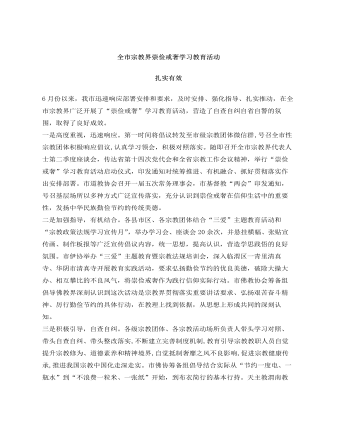
全市宗教界崇俭戒奢学习教育活动总结汇报
天主教渭南教区举行“崇俭戒奢”教育活动座谈会,进一步统一思想认识,清醒认识宗教领域贪大求奢、借教敛财、铺张浪费等不良风气的严重危害,突出问题导向,坚持自查自改,要求秉持俭朴理念,发扬勤俭节约、朴实无华、清净庄严等优良传统,使厉行节约、崇尚简朴的理念在全市天主教界蔚然成风。四是固化经验,常抓抓常。按照省民宗委、各全省性宗教团体统一部署要求和总体安排,一是结合“三爱”主题教育和爱国主义教育活动,广泛深入推进“崇俭戒奢”宣传教育,以实际行动响应倡议,以实际成效树立形象,扎实推进我国宗教中国化。二是引导各级宗教团体持续拓展中国化内涵,把“三爱”主题教育与“四进”活动相结合,突出自身特点、时代精神、中国特色,推动“崇俭戒奢”教育活动深入人心、落地见效。三是督导各宗教场所提高站位、深化认识,发扬宗教适应社会、服务社会的优良传统,增强政治自觉和行动自觉,为社会主义现代化和中华民族伟大复兴更好的发挥宗教积极作用。
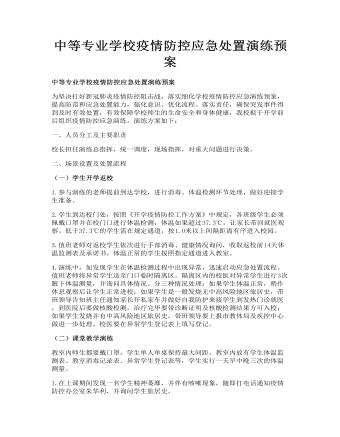
中等专业学校疫情防控应急处置演练预案
1.参与演练的老师提前到达学校,进行消毒、体温检测环节处理,做好迎接学生准备。2.学生到达校门处,按照《开学疫情防控工作方案》中规定,各班级学生必须佩戴口罩并在校门口进行体温检测,体温如果超过37.3℃,让家长带回就医观察。低于37.3℃的学生需在规定通道,按1.0米以上间隔距离有序进入校园。3.值班老师对返校学生依次进行手部消毒、健康情况询问,收取返校前14天体温监测表及承诺书。体温正常的学生按照指定通道进入教室。
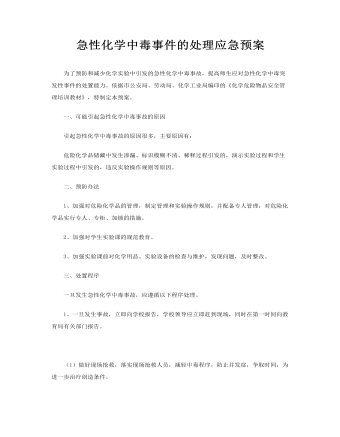
急性化学中毒事件的处理应急预案
1、加强对危险化学品的管理,制定管理和实验操作规则,并配备专人管理,对危险化学品实行专人、专柜、加锁的措施。 2、加强对学生实验课的规范教育。 3、加强实验课前对化学用品、实验设备的检查与维护,发现问题,及时整改。 三、处置程序 一旦发生急性化学中毒事故,应遵循以下程序处理。 1、一旦发生事故,立即向学校报告,学校领导应立即赶到现场,同时在第一时间向教育局有关部门报告。
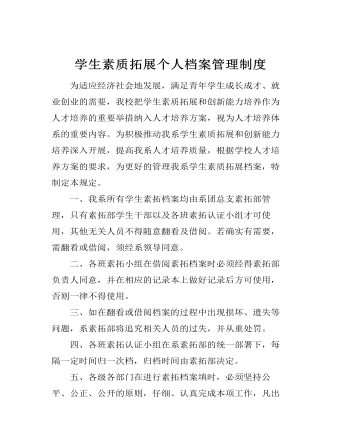
学生素质拓展个人档案管理制度
一、我系所有学生素拓档案均由系团总支素拓部管理,只有素拓部学生干部以及各班素拓认证小组才可使用,其他无关人员不得随意翻看及借阅。若确实有需要,需翻看或借阅,须经系领导同意。 二、各班素拓小组在借阅素拓档案时必须经得素拓部负责人同意,并在相应的记录本上做好记录后方可使用,否则一律不得使用。
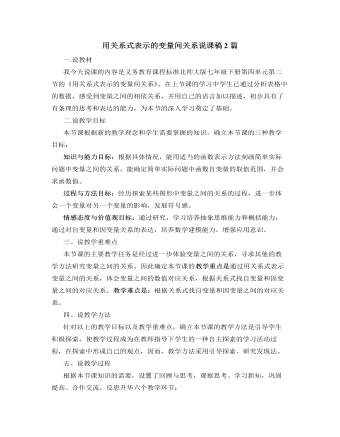
北师大版初中七年级数学下册用关系式表示的变量间关系说课稿2篇
一.说教材我今天说课的内容是义务教育课程标准北师大版七年级下册第四单元第二节的《用关系式表示的变量间关系》。在上节课的学习中学生已通过分析表格中的数据,感受到变量之间的相依关系,并用自己的语言加以描述,初步具有了有条理的思考和表达的能力,为本节的深入学习奠定了基础。二.说教学目标本节课根据新的教学理念和学生需要掌握的知识,确立本节课的三种教学目标:知识与能力目标:根据具体情况,能用适当的函数表示方法刻画简单实际问题中变量之间的关系,能确定简单实际问题中函数自变量的取值范围,并会求函数值。过程与方法目标:经历探索某些图形中变量之间的关系的过程,进一步体会一个变量对另一个变量的影响,发展符号感。情感态度与价值观目标:通过研究,学习培养抽象思维能力和概括能力,通过对自变量和因变量关系的表达,培养数学建模能力,增强应用意识。
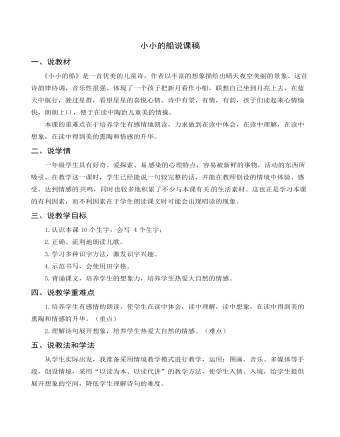
《小小的船》说课稿
学生在朗读同时也在接受美的熏陶。在教学中,我始终重视让“趣”字贯穿整个教学过程,在读读、想想、说说中感受美,培养想象力并进行朗读训练。
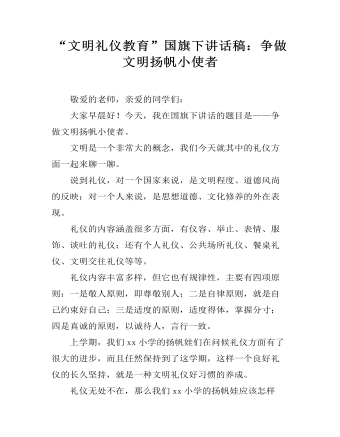
“文明礼仪教育”国旗下讲话稿:争做文明扬帆小使者
敬爱的老师,亲爱的同学们:大家早晨好!今天,我在国旗下讲话的题目是——争做文明扬帆小使者。文明是一个非常大的概念,我们今天就其中的礼仪方面一起来聊一聊。说到礼仪,对一个国家来说,是文明程度、道德风尚的反映;对一个人来说,是思想道德、文化修养的外在表现。礼仪的内容涵盖很多方面,有仪容、举止、表情、服饰、谈吐的礼仪;还有个人礼仪、公共场所礼仪、餐桌礼仪、文明交往礼仪等等。礼仪内容丰富多样,但它也有规律性,主要有四项原则:一是敬人原则,即尊敬别人;二是自律原则,就是自己约束好自己;三是适度的原则,适度得体,掌握分寸;四是真诚的原则,以诚待人,言行一致。上学期,我们xx小学的扬帆娃们在问候礼仪方面有了很大的进步,而且任然保持到了这学期,这样一个良好礼仪的长久坚持,就是一种文明礼仪好习惯的养成。礼仪无处不在,那么我们xx小学的扬帆娃应该怎样做,才能进一步彰显文明礼仪呢?
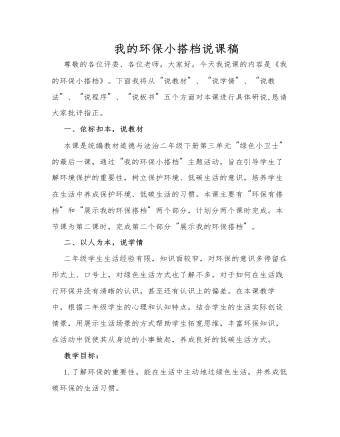
人教部编版道德与法制二年级下册我的环保小搭档说课稿
小结:相信随着科技的进步,会有更多的垃圾变宝贝,看来只要用心发现,动手创造,我们可以利用的环保小搭档可真不少。展示“家庭环保小搭档”环节,从学校生活过渡到家庭生活,以填表的形式降低学生交流难度。口头的交流不足以让学生有清晰的认识,课前已让学生搜集相关内容,通过图片、视频等内容展示分享,让学生对“环保小搭档”有更清晰的认识,在交流分享过程中,努力让学生意识到过有创意的绿色生活的重要性、必要性。活动四:“环保”知多少我们为环保助力的行为既是大家倡导的,也是受到法律保护的,开启环保之旅第四站——科普馆1.出示与环境保护有关的节日2.了解《中华人民共和国环境保护法》拓展补充有关中国及世界上有关环保的节日,同时了解《中华人民共和国环境保护法》。
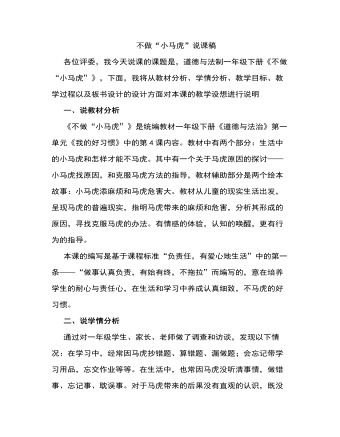
人教部编版道德与法制一年级下册不做“小马虎”说课稿
预设3:做完作业没检查。师:你做什么作业没检查结果怎么了师:原来做完事情不检查会让我们马虎预设4:做事太粗心大意了。师:你做哪件事粗心大意了结果怎么样师:原来做事粗心大意也会让我们马虎预设5:做事不认真。师:你做了件什么事不认真结果怎么样师:原来做事不认真会让我们马虎。2.“智慧仙子”有秘方师:本侦探可不是小马虎,所谓为了搞清楚马虎的原因,特意去请教了智慧仙子。看看她认为马虎的原因有哪些。(图片出示智慧仙子,并点击马虎的原因)师:小朋友们,我们知道的马虎给我们带来那么多的麻烦,也了解了马虎的原因,我们要不要做小马虎啊生:不要做师:对啦,我们不做小马虎,并板贴“不做”。小朋友们,这纸上有很多你做过的马虎事,让我们用力把他揉成一团,把小马虎扔进垃圾箱,从此告别这些马虎事,好不好
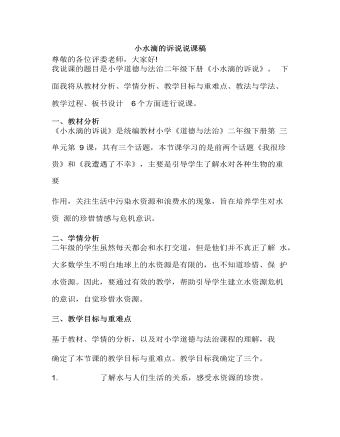
人教部编版道德与法制二年级下册小水滴的诉说说课稿
设计意图:发现生活中污染、浪费水资源的现象,明白可以靠 法律法规的作用,切实有效地保护水资源。活动三:我们和小水滴 课件出示儿歌《我们和小水滴》,学生先自己诵读,再齐读。 设计意图:学以致用,深入感受水资源的珍贵,自觉珍惜水资源。环节三:感悟明理,育情导行 学生谈一谈学习本节课的收获,教师相机引导。 设计意图:梳理总结,体验收获与成功的喜悦,内化提升学生的认识与情感。环节四:拓展延伸,回归生活 生活中,大家要自觉珍惜水资源。设计意图: 将课堂所学延伸到学生的日常生活中,有利于落实行 为实践。六、板书设计为了突出重点, 让学生整体上感知本节课的主要内容, 我将以思 维导图的形式设计板书: 在黑板中上方的中间位置是课题 《小水滴的 诉说》,下面左边是板画的小水滴, 右边从上到下依次是宝贵, 稀少, 珍惜。
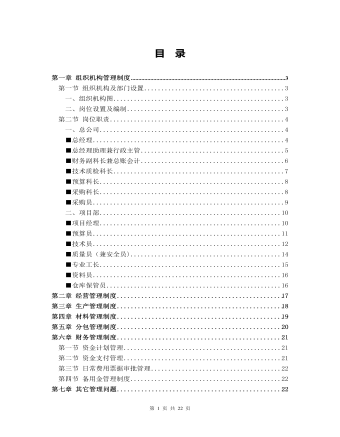
公司管理制度(适用于园林景观)
第二节岗位职责一、总公司■总经理□直接上级:董事长□直接下级:总经理助理、行政人事主管、总账会计、技术质检科长、预算科长、采购科长、各项目经理□岗位职责:1、根据公司战略规划、方针要求,全面主持园林公司的日常经营、生产与管理工作,是公司各项责任状指标落实的第一责任人。2、负责组织召开各种办公会议,对经营生产管理工作进行部署,审议会议决议并督促落实执行。3、负责主持公司市场经营工作:(1)按照市场定位、业务承接定位要求对业务信息进行评估、筛选、把关;(2)组织确定谈判策略,组织做好业务洽谈工作;(3)主持公司内部对招标文件、业务承诺书、投标文件、业务合同、居间合同等的评审工作,并直接对工程合同等逐条进行把关;4、负责公司生产管理工作:(1)全面做好公司生产计划、生产作业的指导工作,抓好项目质量保证体系的运行工作;(2)负责各项目部人、财、物的总体调度和计划的审核;(3)负责组织对各项目的综合检查评比工作;5、外部关系的管理工作:(1)定期与甲方沟通,调研客户满意度状况,并根据调研结果采取措施,提升客户满意度;(2)组织推进公司战略合作伙伴的开发、维护工作,并定期直接与战略合作伙伴进行沟通、协调;(3)负责政府等重大公共关系建设工作。6、督促、协助各项目部做好工程款回收工作。7、全面负责项目成本管理工作;8、参与拟定公司各岗位职责、工作流程、工作标准、准则、操作手册的编制与修订,经审议后负责组织推进实施。9、履行档案管理职责,根据本项目部不同种类文件材料形成的特征,负责本项目部文件材料的形成、积累、保管和整理立卷归档工作,保证归档文件材料完整、准确、系统。并按规定时间移交本项目部集中保管.10、根据票据审批制度规定的权限审核相关人员所发生的费用票据。11、不断收集标杆企业企业管理的相关资料,通过调研、研究、借鉴、吸收、完善逐渐提升公司企业管理水平和能力.12、完成直接上级交办的其它工作.
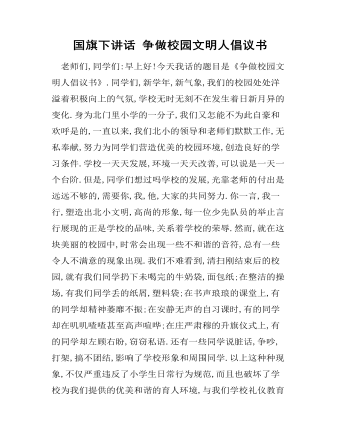
国旗下讲话 争做校园文明人倡议书
老师们,同学们:早上好!今天我话的题目是《争做校园文明人倡议书》.同学们,新学年,新气象,我们的校园处处洋溢着积极向上的气氛,学校无时无刻不在发生着日新月异的变化.身为北门里小学的一分子,我们又怎能不为此自豪和欢呼是的,一直以来,我们北小的领导和老师们默默工作,无私奉献,努力为同学们营造优美的校园环境,创造良好的学习条件.学校一天天发展,环境一天天改善,可以说是一天一个台阶.但是,同学们想过吗学校的发展,光靠老师的付出是远远不够的,需要你,我,他,大家的共同努力.你一言,我一行,塑造出北小文明,高尚的形象,每一位少先队员的举止言行展现的正是学校的品味,关系着学校的荣辱.然而,就在这块美丽的校园中,时常会出现一些不和谐的音符,总有一些令人不满意的现象出现.我们不难看到,清扫刚结束后的校园,就有我们同学扔下未喝完的牛奶袋,面包纸;在整洁的操场,有我们同学丢的纸屑,塑料袋;在书声琅琅的课堂上,有的同学却精神萎靡不振;在安静无声的自习课时,有的同学却在叽叽喳喳甚至高声喧哗;在庄严肃穆的升旗仪式上,有的同学却左顾右盼,窃窃私语.还有一些同学说脏话,争吵,打架,搞不团结,影响了学校形象和周围同学.以上这种种现象,不仅严重违反了小学生日常行为规范,而且也破坏了学校为我们提供的优美和谐的育人环境,与我们学校礼仪教育的主流不相符.本学期一开学,学校便把第一个月定为"德育工作月",把第一周定为"行为习惯养成周",并在全校启动"争做校园文明人"活动.
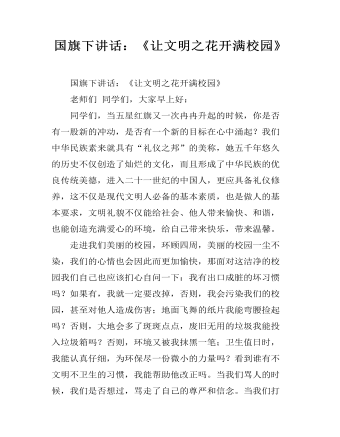
国旗下讲话:《让文明之花开满校园》
老师们 同学们,大家早上好:同学们,当五星红旗又一次冉冉升起的时候,你是否有一股新的冲动,是否有一个新的目标在心中涌起?我们中华民族素来就具有“礼仪之邦”的美称,她五千年悠久的历史不仅创造了灿烂的文化,而且形成了中华民族的优良传统美德,进入二十一世纪的中国人,更应具备礼仪修养,这不仅是现代文明人必备的基本素质,也是做人的基本要求,文明礼貌不仅能给社会、他人带来愉快、和谐,也能创造充满爱心的环境,给自己带来快乐,带来温馨。走进我们美丽的校园,环顾四周,美丽的校园一尘不染,我们的心情也会因此而更加愉快,那面对这洁净的校园我们自己也应该扪心自问一下:我有出口成脏的坏习惯吗?如果有,我就一定要改掉,否则,我会污染我们的校园,甚至对他人造成伤害;地面飞舞的纸片我能弯腰捡起吗?否则,大地会多了斑斑点点,废旧无用的垃圾我能投入垃圾箱吗?否则,环境又被我抹黑一笔


